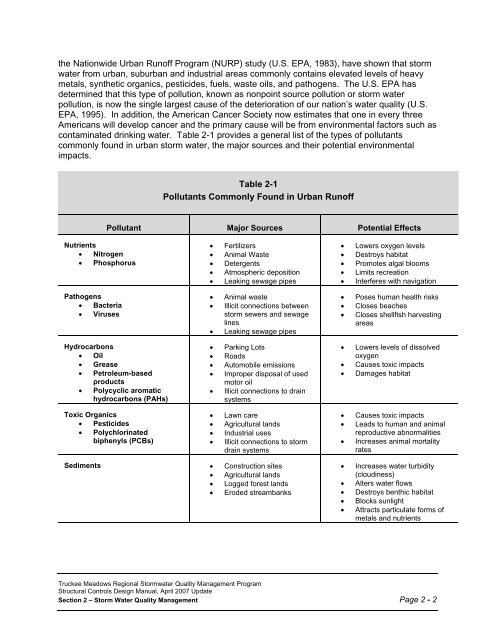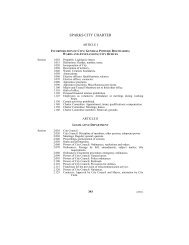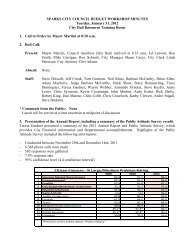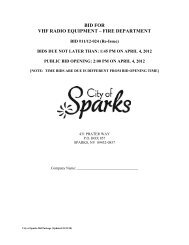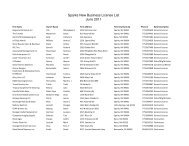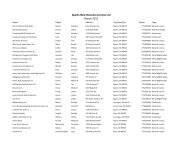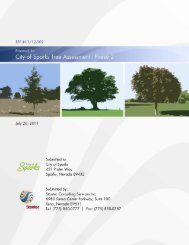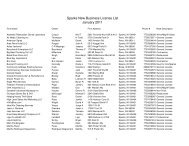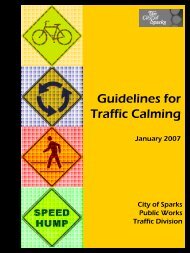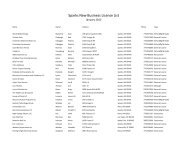The Truckee Meadows Structural Controls Design ... - City of Sparks
The Truckee Meadows Structural Controls Design ... - City of Sparks
The Truckee Meadows Structural Controls Design ... - City of Sparks
Create successful ePaper yourself
Turn your PDF publications into a flip-book with our unique Google optimized e-Paper software.
the Nationwide Urban Run<strong>of</strong>f Program (NURP) study (U.S. EPA, 1983), have shown that storm<br />
water from urban, suburban and industrial areas commonly contains elevated levels <strong>of</strong> heavy<br />
metals, synthetic organics, pesticides, fuels, waste oils, and pathogens. <strong>The</strong> U.S. EPA has<br />
determined that this type <strong>of</strong> pollution, known as nonpoint source pollution or storm water<br />
pollution, is now the single largest cause <strong>of</strong> the deterioration <strong>of</strong> our nation’s water quality (U.S.<br />
EPA, 1995). In addition, the American Cancer Society now estimates that one in every three<br />
Americans will develop cancer and the primary cause will be from environmental factors such as<br />
contaminated drinking water. Table 2-1 provides a general list <strong>of</strong> the types <strong>of</strong> pollutants<br />
commonly found in urban storm water, the major sources and their potential environmental<br />
impacts.<br />
Pollutant<br />
Nutrients<br />
• Nitrogen<br />
• Phosphorus<br />
Pathogens<br />
• Bacteria<br />
• Viruses<br />
Hydrocarbons<br />
• Oil<br />
• Grease<br />
• Petroleum-based<br />
products<br />
• Polycyclic aromatic<br />
hydrocarbons (PAHs)<br />
Toxic Organics<br />
• Pesticides<br />
• Polychlorinated<br />
biphenyls (PCBs)<br />
Sediments<br />
Table 2-1<br />
Pollutants Commonly Found in Urban Run<strong>of</strong>f<br />
Major Sources<br />
• Fertilizers<br />
• Animal Waste<br />
• Detergents<br />
• Atmospheric deposition<br />
• Leaking sewage pipes<br />
• Animal waste<br />
• Illicit connections between<br />
storm sewers and sewage<br />
lines<br />
• Leaking sewage pipes<br />
• Parking Lots<br />
• Roads<br />
• Automobile emissions<br />
• Improper disposal <strong>of</strong> used<br />
motor oil<br />
• Illicit connections to drain<br />
systems<br />
• Lawn care<br />
• Agricultural lands<br />
• Industrial uses<br />
• Illicit connections to storm<br />
drain systems<br />
• Construction sites<br />
• Agricultural lands<br />
• Logged forest lands<br />
• Eroded streambanks<br />
Potential Effects<br />
• Lowers oxygen levels<br />
• Destroys habitat<br />
• Promotes algal blooms<br />
• Limits recreation<br />
• Interferes with navigation<br />
• Poses human health risks<br />
• Closes beaches<br />
• Closes shellfish harvesting<br />
areas<br />
• Lowers levels <strong>of</strong> dissolved<br />
oxygen<br />
• Causes toxic impacts<br />
• Damages habitat<br />
• Causes toxic impacts<br />
• Leads to human and animal<br />
reproductive abnormalities<br />
• Increases animal mortality<br />
rates<br />
• Increases water turbidity<br />
(cloudiness)<br />
• Alters water flows<br />
• Destroys benthic habitat<br />
• Blocks sunlight<br />
• Attracts particulate forms <strong>of</strong><br />
metals and nutrients<br />
<strong>Truckee</strong> <strong>Meadows</strong> Regional Stormwater Quality Management Program<br />
<strong>Structural</strong> <strong>Controls</strong> <strong>Design</strong> Manual, April 2007 Update<br />
Section 2 – Storm Water Quality Management Page 2 - 2


